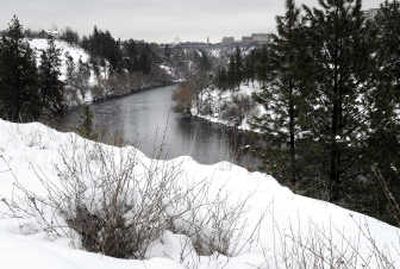Discharge permits on hold

Five years past due, it will be at least six more months before pollution discharge permits will be issued for cities and businesses on the Spokane River because of objections from the U.S. Environmental Protection Agency and others.
The Washington Department of Ecology planned to issue wastewater discharge permits by Jan. 1, but the permits are being revised because of questions raised during a public comment period, spokeswoman Jani Gilbert said.
Resolving the EPA’s objections, which parallel concerns of environmentalists, is most critical. Without EPA approval, the Department of Ecology can’t issue any permits.
The department also is revising its water quality improvement plan, which sets the limit for the amount of phosphorus that can be discharged into the river.
Permits for the cities of Spokane and Liberty Lake, plus Kaiser Aluminum and Inland Empire Paper Co., can’t be finalized until the water quality plan is revised. Inland Empire Paper is a subsidiary of Cowles Co., which also owns The Spokesman-Review.
At issue is how much total phosphorus will be allowed in the river from all permitted dischargers. As anyone who has fertilized a lawn has witnessed, phosphorus feeds plants. In the river, it is feeding algae blooms that are a summer problem at Long Lake, a Spokane River reservoir sometimes called Lake Spokane.
The goal is to reduce those phosphorus discharges by 95 percent in coming years, a reduction that require millions of dollars in upgrades at the plants and factories that have discharge permits.
About 70 written comments were received on the water quality plan, Gilbert said. In addition, at least 40 comments were received on the draft discharge permits.
It’s taking Ecology staff longer than expected to sort through and respond to comments, she said.
Several issues were raised repeatedly, Gilbert said.
Some question the science the Department of Ecology used to come up with the amount of phosphorus that could be discharged under the permits.
The EPA in a Dec. 3 letter objected to the fact that the water quality improvement plan set limits on phosphorus and other pollutants, but permits did not address limits to other pollutants.
EPA permit writer Lisa Olson said permits for Spokane and Liberty Lake didn’t even contain limits for phosphorus.
The time frame for implementing changes and reducing pollution discharges also drew criticism. Under the draft permits, dischargers were given 10 years to meet water quality standards, but that deadline could be extended another 10 years if the standards aren’t met.
The EPA faulted Ecology for not setting an “enforceable” deadline for compliance.
Gilbert said Ecology’s deadline was flexible because of the new and “untested” technology required to reduce the amount of pollution going into the river.
But the EPA said it’s “possible and necessary” to set firm deadlines. The EPA is also requiring Ecology to set some interim limits.
At the least, Olson said, the EPA wants to “keep levels where they are now. To not get worse before we get better.”
“We’re working with Ecology so they can get (the permits) the way that we want them so we can withdraw our objections,” Olson said. “They’re cooperating and we’re working together.”
The EPA didn’t escape criticism from people who filed written comments.
A concern raised repeatedly was the amount of phosphorus that sewage treatment plants in Idaho can discharge and how that figures into the limits set for Washington dischargers. Those Idaho plants are in Coeur d’Alene, Post Falls and Hayden.
EPA-issued draft permits “have allowed the three small dischargers in Idaho to take the entire legal load of pollution” allowed to be discharged into the river, said Rick Eichstaedt, an attorney with the public interest law firm the Center For Justice, representing the Sierra Club.
The EPA told the Department of Ecology to assume that any phosphorus crossing the state line is naturally occurring.
Environmentalists believe that assumption allows more phosphorus to be discharged than permitted by federal law, potentially doubling the amount of pollution in the river.
“That’s another big area of contention we’ll be addressing and discussing in the coming weeks,” Gilbert said.
Inland Empire Paper Co. and other dischargers have operated under extended discharge permits for five years.
Doug Krapas, Inland’s environmental compliance engineer, said further delays in the permit process are frustrating.
“It’s disappointing because it’s just delaying the inevitable,” he said. “We all want to move forward. We all want to make improvements. The dischargers are all committed to improving water quality and river quality.”
Inland Empire Paper Co. is investing $15 million to $20 million for equipment to reduce pollutants, Krapas said. Without knowing what limits will be set, “there’s a risk involved in moving forward,” he said.
Exactly how substantive any necessary changes to the water quality plan and permits will be hasn’t been determined, Gilbert said. If major changes are made, the public will have another chance to comment, she said.
The Department of Ecology plans to have a draft of the cleanup plan ready by March 1 and that same week will meet with stakeholders, including dischargers, the Sierra Club and others.
The goal for finalizing the plan is April 1.
Then, discharge permits will be available for public review and comment for a two weeks. The final discharge permits could be issued by June 15, Gilbert said.
While the delay is frustrating dischargers, Eichstaedt said, he’s happy the Department of Ecology is taking time to re-evaluate and address the concerns.
“We’ve told Ecology from the beginning we would rather them take the time to do it right,” Eichstaedt said. “Our hope is since they’ve now allowed themselves six months on the permits and another four months on the (phosphorus limits) that they take a serious look at the comments and come out with documents that, one, actually clean up the river and, two, are legally sound.”